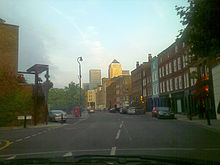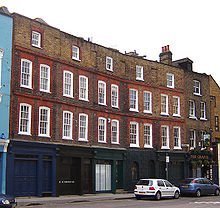- Narrow Street
-
Coordinates: 51°30′32″N 0°2′1″W / 51.50889°N 0.03361°W
Narrow Street is a narrow street running parallel to the River Thames through the Limehouse area of east London.
 Looking the other way from the above picture, shows four of the high rise buildings of Canary Wharf, Sept. 2007.
Looking the other way from the above picture, shows four of the high rise buildings of Canary Wharf, Sept. 2007.
Contents
History
A combination of tides and currents made this point on the Thames a natural landfall for ships, the first wharf being completed in 1348. Lime kilns or 'Lymehostes' used in the production of mortar and pottery were built at this location in the fourteenth century. The area grew rapidly in Elizabethan times as a centre for world trade and by the reign of James I nearly half of the area's 2,000 population were mariners. The area supplied ships with ropes and other necessities; pottery was also made here for the ships. Ship chandlers settled here building wooden houses and wharves in the cramped space between street and river, indeed Narrow Street may take its name from the closeness of the original buildings, now demolished, which stood barely a few metres apart on each side of the street.
The Limehouse Bridge Dock was established in 1766, for barges and small ships to access the Limehouse Cut, which led to the Lee Navigation. Limehouse Basin was built in 1820, to transship imported goods to barges on the Regent's Canal. The two were linked in the early 19th century, and the lock from the Cut to the river, filled in.
In 1661, Samuel Pepys wrote in his diary of a visit to a porcelain factory in Narrow Street alighting via Duke Shore Stairs[1][2] while en route to view work on boats being built for Herring fishing. The Limehouse area fitted out, repaired and resupplied ships. In 1772, Smith & Sykes ran a sugar house a small factory that baked and refined sugar.[3] In 1823, Taylor Walker & Co Ltd started brewing at the site of today's pub The Narrow formerly The Barley Mow. Limehouse Cut was redirected into Limehouse Basin was one of the first docks to close in the late 1960s. Nicholas Hawksmoors’ Church St Anne's Limehouse was designated a conservation area by the London Docklands Development Corporation in the 1980s.
For much of the 20th century the area was dominated by the tall chimney of Stepney Power Station at Blyth Wharf, which has since been demolished.
Access to the area was always difficult, with the dock standing to the north, and the entrance to the Rotherhithe Tunnel at one end. In 1993 the 1.8 kilometres (1.1 mi) Limehouse Link tunnel was completed; further restricting traffic to the riverside area. The Narrow Street Swing Bridge is sited between the Limehouse Basin Lock and the Thames.
Chinatown
In the eighteenth century a small group of Chinese sailors from Canton and Southern China settled along the old Limehouse Causeway creating the original London Chinatown. The Chinese community later moved to Soho following heavy bombing of the area during World War II often referred to as the Blitz.
Historic buildings
A number of historic buildings remain, including The Grapes public house, which was notably bought in 2011 by actor Sir Ian McKellen, director Sean Mathias and Evening Standard owner, Evgeny Lebedev[4]. Next to The Grapes is a rare example of an early Georgian brick terrace. Early Georgian houses can be distinguished from late ones in the way that the windows are not set back from the brick frontage.
Redevelopment
The late twentieth century brought much development to the area, with the erection of the Canary Wharf tower close by. Since the 1990s, many new apartment complexes have been built around the Limehouse Basin as well as Victorian warehouse conversions, with Limehouse now being one of the most sought after property sites in London. Its close proximity to the River Thames has made property prices around Limehouse and the Docklands soar over the last decade. However a 2001 Census [1] listed 5.4% of Homes in Poplar and Limehouse as being without central heating and/or private bathroom.
The street is home to a number of good pubs and restaurants, including The Narrow, a gastropub run by Gordon Ramsay, and Booty's Riverside Bar, an independently-owned pub which dates back to the 16th Century, with 19th century frontage. In the 18th century Booty’s was an engineering shop for the barge builders, Sparkes. By the 1870’s it was a licensed bar called The Waterman’s Arms owned by Taylor Walker, before being absorbed by Woodward Fisher, a lighterage firm run by Anne Fisher, popularly known as ‘'Tugboat Annie'’, a local real-life London version of the character in the film of that name. One of the great East End characters, she commanded a fleet of 200 barges.
Famous residents include the actors Sir Ian McKellen and Steven Berkoff, and politicians Lord David Owen, Cleo Rocos and Matthew Parris. It was also the home of the film director Sir David Lean, whose Narrow Street house, regarded as one of the best riverside houses in London, is still owned by his family.
Art and literature
During the eighteenth and nineteenth centuries Narrow Street's harsh conditions and extreme poverty attracted the attention of early social reformers and latter political agitation for better working conditions led to the creation of some of London's earliest trade unions.
Its picturesque buildings and atmospheric location abutting onto the River Thames also attracted artists and writers.
- Charles Dickens' godfather Christopher Huffam ran his sail-making business from Newell Street, Limehouse.
- James McNeill Whistler and Charles Napier Hemy sketched and painted at locations on Narrow Streets' river waterfront.
- Arthur Conan Doyle's fictional detective Sherlock Holmes visits an opium den in Limehouse looking for clues.
- George Orwell's book Down and Out in Paris and London features a Limehouse lodging house.
Transport
In 2010 the street became part of CS3, a continuous cycle route from Aldgate to Barking and one of London's first Cycle Superhighways. In October residents raised a petition calling for CS3 to be moved from Narrow Street onto the A13 Commercial Road, arguing that the street was too narrow and that incidents of abuse and aggression had risen sharply since the route was introduced. Transport for London (TfL) said they had no plans to move it. Mayor Boris Johnson defended the choice as a road that was already popular with cyclists to and from the City.[5] The London Cycling Campaign supported the route but called for improvements.[6] In 2011, TfL agreed to remove logos from the road surface, but not to change the route.[7]
- Nearest places
- Isle of Dogs
- Stepney
- Poplar
- Ratcliffe
- Limehouse Cut
- St Dunstan's, Stepney
- St Anne's Limehouse
The nearest Docklands Light Railway stations are Limehouse and Westferry
- River boat service piers
See also
- Henry Mayhew
- George Robert Sims
- Sir Walter Besant
- Clement Attlee
- Colin Gwyer & Associates Ltd v London Wharf (Limehouse) Ltd [2003] BCC 885, litigation which took place on a Narrow Street property
- Stepney Historical Trust
Notes
- ^ Saturday 19 October 1661 (Pepys' Diary)
- ^ Public stairs on the Thames - 18th Century London
- ^ wapping
- ^ "The Grapes, History", thegrapes.co.uk.
- ^ Our street is too narrow for a cycle superhighway, Evening Standard, 27 October 2010
- ^ Do you think Narrow Street is wide enough for bicycles?, London Cycling Campaign, November 2010
- ^ Marina Thomas (8 February 2011). "Narrow Street cycle highway logos to be removed after campaign". The Docklands. Archant. Archived from the original on 2011-02-12. http://www.webcitation.org/query?url=http%3A%2F%2Fwww.docklands24.co.uk%2Fnews%2Fnarrow_street_cycle_highway_logos_to_be_removed_after_campaign_1_795887&date=2011-02-12. Retrieved 2011-02-12.
The Anglo-Saxon word tirl, means 'narrow street' or a 'gate' to keep horses and other cattle out of the city.
External links
- LDDC
- Chinatown
- Taylor Walker & Co http://www.quaffale.org.uk/php/brewery/746
- Limehouse http://www.eolfhs.org.uk/parish/limehouse.htm
- Early history http://www.mernick.co.uk/thhol/limehouse.html
- Early history http://www.towerhamlets.gov.uk/data/discover/data/Poplar/index.cfm
- Duke Shore stairs http://www.burkes-peerage.net/sites/common/sitepages/lwallindex.asp
- Image reference: Greenwood's Map of London 1827 http://users.bathspa.ac.uk/greenwood/imagemap.html
- Image reference: Limehouse Link 1993
Categories:- Thames Path
- Streets in Tower Hamlets
Wikimedia Foundation. 2010.

